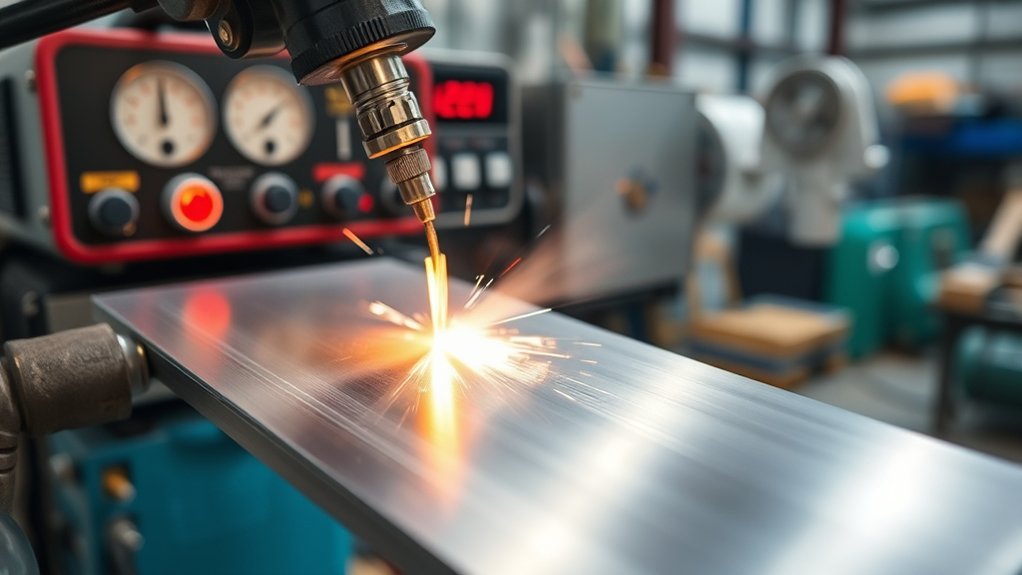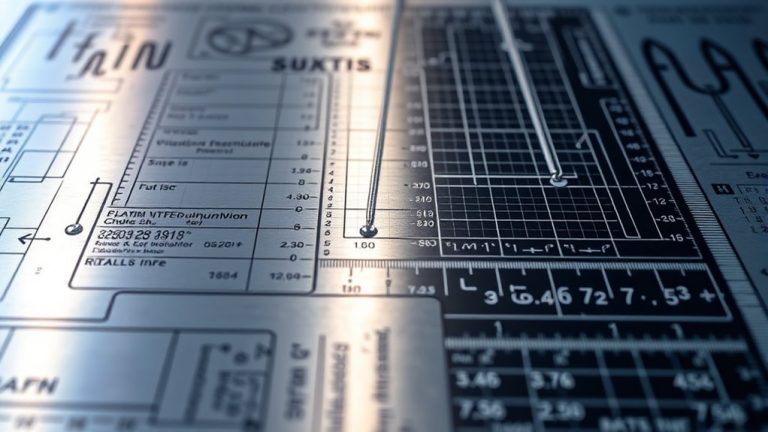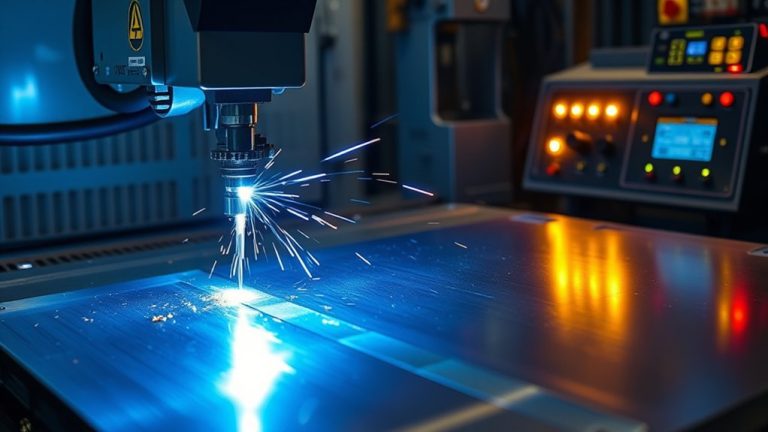Did you know that when plasma cutting aluminum, using nitrogen as the plasma gas can greatly reduce oxidation? This choice, coupled with setting your plasma cutter to around 45 amps for 1/8 inch thickness, will help you achieve cleaner cuts. Balancing this with a cutting speed of 70-75 inches per minute is essential for minimizing dross. However, there’s much more to reflect on, like torch height and grounding, to master the process.
Understanding Aluminum’s Properties for Plasma Cutting

When it comes to plasma cutting aluminum, understanding its unique properties is crucial for achieving precision and efficiency. Aluminum’s low melting point of 660°C (1220°F) demands meticulous management of heat to prevent warping.
Mastering aluminum’s properties is key to precise, efficient plasma cutting and avoiding warping from its low melting point.
Its high thermal conductivity means you must carefully control amperage and cutting speed to maintain ideal cut quality. The metal’s softness allows for higher cutting speeds, yet these speeds must be adjusted according to the thickness of aluminum to guarantee clean edges.
In practice, plasma cutting aluminum requires specific attention to the alloy type, such as 6061, known for its strength and corrosion resistance. Each alloy demands tailored settings to enhance performance.
To minimize dross production and improve cut quality, adjust the torch height and speed carefully. By understanding these properties and making precise adjustments, you can effectively manage heat and achieve superior results in plasma cutting aluminum.
Selecting the Right Plasma Cutter for Aluminum

While selecting the right plasma cutter for aluminum, prioritize inverter-based models for their efficiency and stable arc performance, vital for handling thinner materials effectively.
In these plasma cutting systems, high-frequency plasma cutters are your go-to option for aluminum cutting, guaranteeing superior cut quality over traditional transformer-based alternatives.
Adjusting the amperage is important; for instance, 45 amps is ideal for 1/8 inch aluminum, providing precise, clean cuts without excess dross.
When dealing with aluminum thicker than 12mm, an argon-hydrogen gas mixture enhances cut quality by minimizing oxidation and improving kerf integrity.
For thicknesses under 5mm, nitrogen serves as the best choice, maintaining a clean edge and reducing thermal distortion.
Also, make sure that your plasma cutter is equipped with proper consumables designed for aluminum’s thermal characteristics.
This attention to detail in equipment selection directly influences the overall efficiency and effectiveness of your aluminum cutting projects.
Importance of Amperage and Power Settings

Understanding the importance of amperage and power settings in plasma cutting aluminum is vital for achieving ideal results. The amperage directly influences the cut quality, particularly in relation to the thickness of the aluminum.
Amperage and power settings are key for optimal plasma cutting results, especially concerning aluminum thickness.
For thinner materials, such as those up to 1/8 inch, setting the amperage around 45 amps is essential for achieving clean and precise cuts. As you tackle thicker aluminum, say over 1/2 inch, you’ll need to increase the amperage considerably to maintain effective cutting and minimize distortion.
The plasma cutting process also demands careful balancing of amperage with cutting speeds. If the amperage is too low, you risk incomplete cuts, while excessively high amperage can lead to unwanted dross and warping.
As a result, monitoring and adjusting your power settings according to the aluminum’s thickness guarantees ideal cut quality. Don’t hesitate to perform test cuts to fine-tune your approach for high-quality cuts.
Gas Selection for Optimal Aluminum Cutting

Balancing proper amperage with cutting speeds is just one part of achieving high-quality plasma cuts on aluminum; gas selection plays an equally essential role. The choice of plasma and shield gases can greatly impact oxidation levels and overall cut quality.
For aluminum less than 5 mm thick, nitrogen is your go-to plasma gas. It minimizes oxidation, ensuring cleaner cuts.
For thicker aluminum sections exceeding 6 mm, consider coupling nitrogen plasma with water as a shield gas. This combination enhances cut quality and reduces dross:
- Nitrogen as plasma gas: Ideal for minimizing oxidation, especially in thinner aluminum.
- Water shield gas: Works well for thick aluminum, enhancing edge quality and reducing dross.
- Avoid oxygen: Using oxygen leads to poor surface quality and increased dross formation.
While air plasma cutters are an option, they risk oxidation, compromising cut quality. Proper gas selection is vital for the best aluminum cutting.
Achieving the Right Cutting Speed and Quality

To achieve ideal cutting speed and quality with aluminum, adjust your plasma cutter to operate within 70-100 ipm, depending on the material’s thickness and amperage settings.
Confirm you’re using 45 amps for 1/8 inch aluminum to avoid excessive dross and maintain a consistent torch height for uniform cuts.
Additionally, selecting the right gas, like nitrogen for thinner sheets, and balancing speed with amperage will prevent arc instability and enhance surface finish.
Optimal Speed Adjustment
When cutting aluminum with a plasma cutter, achieving ideal speed adjustment is essential to balancing cut quality and efficiency. You must consider the best speed, which typically ranges from 70 to 100 inches per minute (ipm), adjusting for the thickness of the material and equipment settings.
Cutting too fast can lead to arc instability and increased dross, while too slow results in excessive heat and wider cuts. For 1/8 inch aluminum, a feed rate of 70-75 ipm at 45 amps is effective for clean cuts.
- Maintain consistent torch height to uphold correct standoff distance.
- Monitor and adjust amperage based on aluminum thickness.
- Balance speed and cut quality, especially for thicker materials.
These practices enhance plasma cutting performance, guaranteeing precision and efficiency.
Quality Enhancement Techniques
After fine-tuning the speed adjustment, it’s time to focus on quality enhancement techniques to achieve the right balance between speed and cutting quality when working with aluminum.
Start by setting the amperage around 45 amps for 1/8 inch aluminum, ensuring enough power for precise cuts without risking overheating. Maintain the torch height as specified in your equipment manual to stabilize the arc and avoid material warping.
Opt for nitrogen as your plasma gas to improve cut quality by reducing oxidation and delivering smoother edges. Aim for a cut speed of 70-75 inches per minute to minimize material waste and dross.
Regularly check and replace consumables like nozzles and electrodes to sustain peak cutting performance and prevent quality degradation.
Consistent Torch Movement
Achieving the right cutting speed and quality with a plasma cutter demands meticulous attention to consistent torch movement. To guarantee high-quality results, maintain a torch movement speed of 70-75 inches per minute (ipm) when working with thin aluminum. This speed minimizes heat input and reduces dross buildup, enhancing cut quality.
Consistent torch speed, paired with the correct amperage—typically 45 amps for 1/8-inch aluminum—is essential for avoiding arc instability and surface roughness.
- Keep the torch at the recommended distance from the workpiece to stabilize the arc and improve cut edges.
- Move the torch in a single direction to prevent uneven cuts and excessive dross.
- Regularly adjust cutting techniques depending on material thickness to optimize performance.
Addressing Common Cutting Challenges

To overcome dross accumulation, adjust the cutting parameters, guaranteeing the correct balance of cutting speed, amperage, and torch height, as excessive heat can lead to subpar edges.
It’s essential to confirm proper grounding, as inadequate ground connections may cause intermittent torch performance and inconsistent cuts.
Additionally, optimizing your torch speed, particularly with thicker materials, can greatly enhance cut quality and reduce distortion.
Overcome Dross Accumulation
When cutting aluminum with a plasma cutter, mitigating dross accumulation is crucial for achieving clean and precise cuts.
To improve cut quality, consider using nitrogen as the plasma gas. This choice reduces oxidation, resulting in cleaner cuts and less dross on the aluminum surface.
Adjust the amperage according to the material’s thickness; higher amperages are necessary for thicker aluminum to guarantee efficient cutting with minimal dross.
Maintain the correct standoff distance for ideal results. A consistent torch height helps prevent poor cut quality and excessive dross formation.
Additionally, regulate the cutting speed. Too fast, and you’ll face incomplete cuts; too slow, and excessive dross will develop.
- Optimize plasma gas selection
- Adjust amperage for material thickness
- Maintain correct standoff distance
Ensure Proper Grounding
A robust grounding setup is one of the key elements in plasma cutting aluminum efficiently. Proper grounding guarantees a stable arc, directly impacting cut quality and minimizing inconsistent cuts.
Start by securely attaching the ground clamp to a clean, uncoated section of the aluminum workpiece. This approach prevents poor electrical conductivity and enhances arc stability.
Inspect the ground cable for damage or corrosion; a compromised connection can lead to arc instability. Position the ground clamp as close to the cutting area as possible to reduce resistance and boost cutting efficiency.
Regularly maintain the ground connection to guarantee consistent performance. By addressing these factors, you’ll mitigate common cutting challenges, guaranteeing a cleaner, more precise cut on aluminum.
Optimize Torch Speed
Achieving ideal torch speed is essential for clean, precise cuts in aluminum using a plasma cutter. Maintaining a recommended speed of 70-75 inches per minute (ipm) for 1/8 inch aluminum is critical.
Deviating from this can lead to:
- Arc instability and surface dross: Cutting too quickly disrupts arc stability, producing unwanted dross and compromising cut quality.
- Excessive heat input: Slower speeds can overheat aluminum, causing distortion, especially in thicker materials.
- Optimal balance challenge: Adjust speeds based on material thickness to guarantee high-quality cuts without overheating.
Consistency in torch height is equally important, guaranteeing proper standoff distance per manufacturer guidelines.
Experimenting with varying speeds and documenting outcomes will help refine your technique, allowing you to optimize torch speed and enhance cutting efficiency.
Techniques for Minimizing Dross Formation

Although dross formation is a common challenge in plasma cutting aluminum, employing precise techniques can greatly mitigate its occurrence.
To enhance cut quality, closely monitor your torch speed, maintaining around 70-75 inches per minute for 1/8 inch aluminum. This reduces dross formation by aligning with the manufacturer’s guidelines.
Also, adjust the amperage to 45 amps for the same material thickness to prevent excessive heat, a key factor in minimizing dross. Choosing the right plasma gas is essential; use nitrogen for both plasma and shield gases for cuts under 5 mm. This choice reduces oxidation and dross accumulation.
Ensure your torch-to-work distance remains consistent as specified in your equipment manual, as variations can lead to uneven cuts and increased dross.
Finally, regularly replace consumables like nozzles and electrodes to maintain cutting efficiency. Worn components degrade cut quality and increase dross, undermining your efforts to achieve a clean, precise cut.
Utilizing Water Tables and Shield Options

When considering the integration of water tables in your aluminum plasma cutting operations, you gain significant advantages in sound, dust, and UV light absorption.
However, you should be mindful of hydrogen gas accumulation, which can pose explosive risks. To enhance cut quality, selecting the right plasma gas and water combination is essential.
For aluminum sections under 5 mm, using nitrogen as both plasma and shield gas is ideal. For thicker sections above 6 mm, combining nitrogen plasma gas with water shield gas improves performance.
- Nitrogen Usage: Ideal for clean cuts, minimizing oxidation and dross.
- Water Tables: Absorb hazardous elements but require careful design to prevent hydrogen buildup.
- Gas Selection: Avoid H-35 or H-2 to mitigate hydrogen risks during underwater cuts.
Regular maintenance and collaboration with experienced companies refine safety and effectiveness, ensuring your aluminum plasma cutting operations are both efficient and secure.
Maintenance and Troubleshooting Tips

While leveraging water tables and the ideal gas combinations for your aluminum plasma cutting operations enhances performance, maintaining equipment is equally important to guarantee consistent results.
Regularly inspect and replace consumables like nozzles and electrodes to avoid poor cut quality and excessive dross buildup. Ensuring the ground clamp’s proper connection to the material is essential, as it prevents cutting issues and inconsistent arcs.
To achieve high-quality cuts, monitor and clean the torch height control mechanism, ensuring the standoff distance remains consistent.
Adjust cutting speed and amperage settings according to aluminum thickness, minimizing heat input to prevent warping or distortion.
Additionally, maintaining a log of settings and results will help you identify successful configurations and troubleshoot recurring issues efficiently.
Frequently Asked Questions
How Does Cutting Aluminum Compare to Cutting Steel With a Plasma Cutter?
When cutting aluminum, consider its thickness, as it needs different settings than steel. You’ll notice faster cutting speeds, potential arc stability issues, and require precise heat management techniques. Guarantee proper metal preparation and post-cutting finishing for quality results.
What Safety Gear Is Recommended for Plasma Cutting Aluminum?
You absolutely can’t compromise on safety. Equip yourself with protective eyewear, heat-resistant gloves, a welding jacket, a respiratory mask, a face shield, and sturdy safety boots. These are essential to shield you from intense heat and hazardous fumes.
Can Plasma Cutting Be Used for Aluminum Alloys?
Yes, you can use plasma cutting for aluminum alloys. Guarantee ideal arc stability by adjusting power settings based on material thickness. Employ precise cutting techniques for clean cuts, considering the specific properties of your chosen aluminum alloy.
How Do Environmental Factors Affect Aluminum Plasma Cutting?
Oh sure, ignore temperature effects, humidity impact, wind influence, surface cleanliness, equipment calibration, and the working environment; it’s not like they matter. But really, they do. They can affect cut quality and equipment lifespan considerably.
What Are the Signs of a Worn-Out Plasma Torch Nozzle?
You’ll notice nozzle wear when the plasma arc becomes unstable, impacting cutting efficiency. Check for irregular cuts and increased dross. Regular maintenance tips help, but troubleshooting methods can reveal deeper issues affecting cut quality.
Conclusion
Mastering aluminum plasma cutting is like wielding Excalibur—precision is your true power. You’ve explored amperage settings, gas choices, and cutting speeds akin to tuning a high-performance engine. Embrace nitrogen to combat oxidation and maintain your torch height like a seasoned pilot maneuvering through turbulent skies. Remember, consistent maintenance is your Excalibur’s sheath, ensuring peak performance. With these insights, you’re equipped to conquer any challenge aluminum throws your way, achieving cuts that are both clean and efficient.



